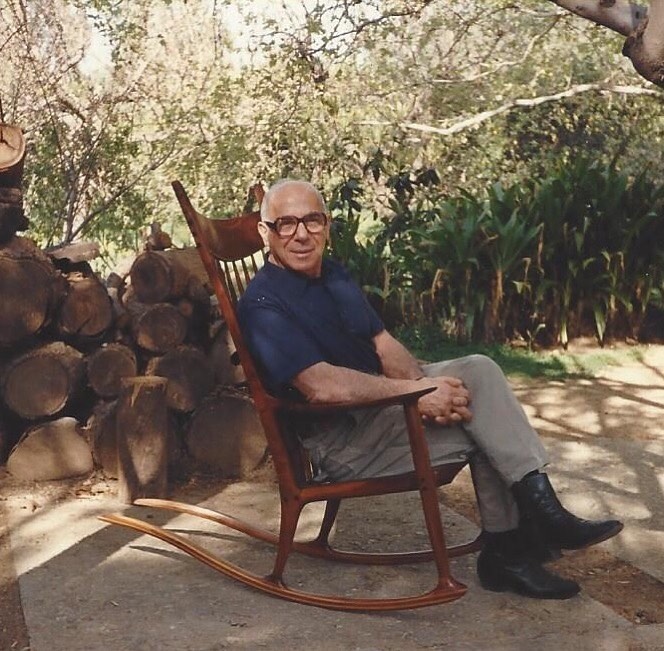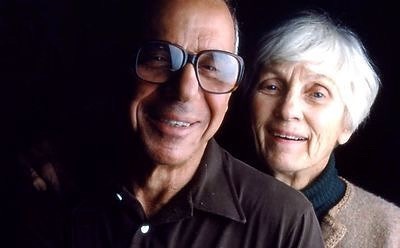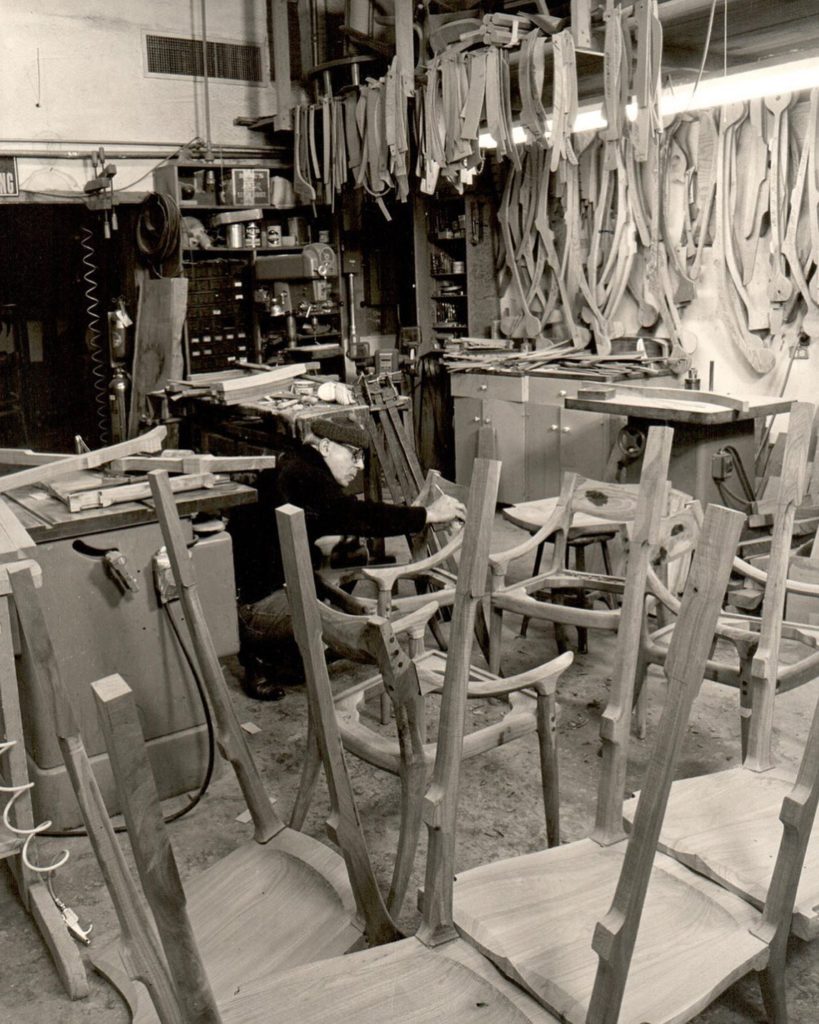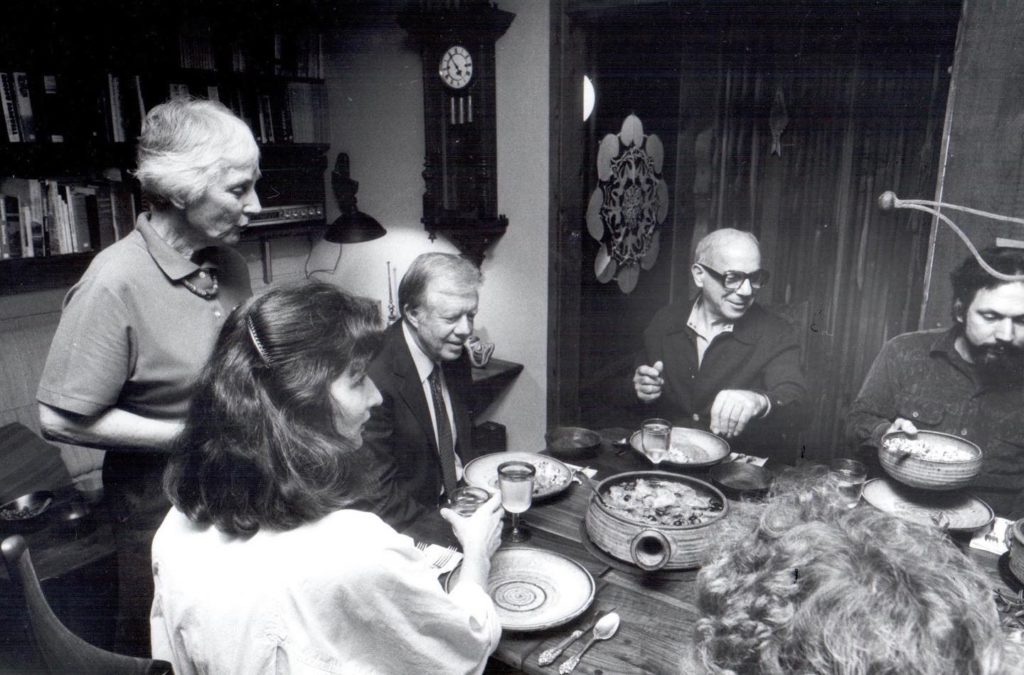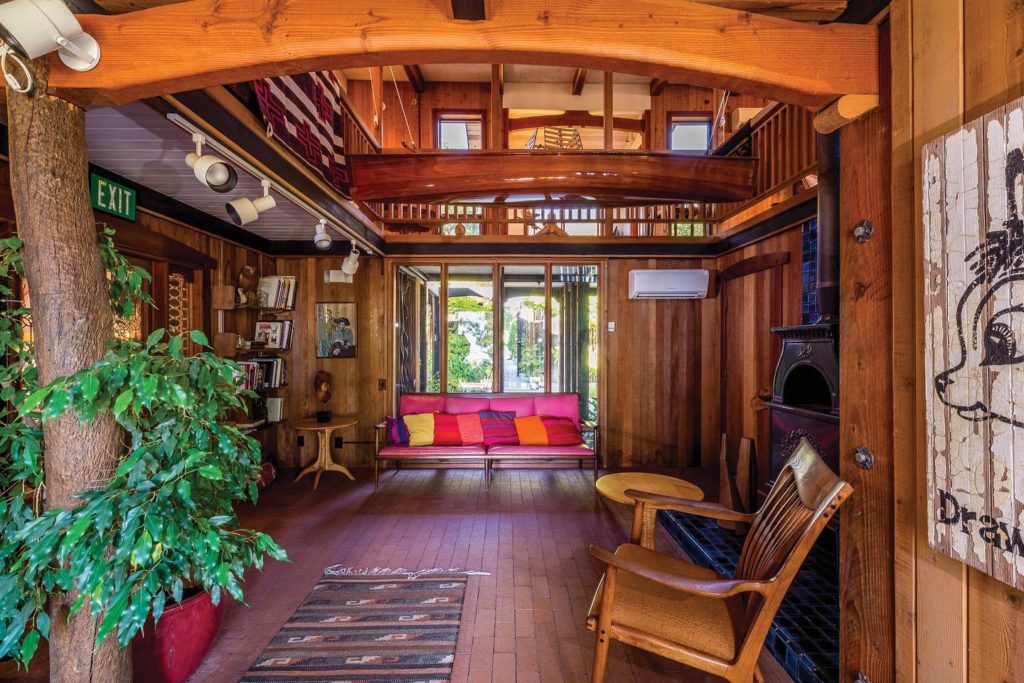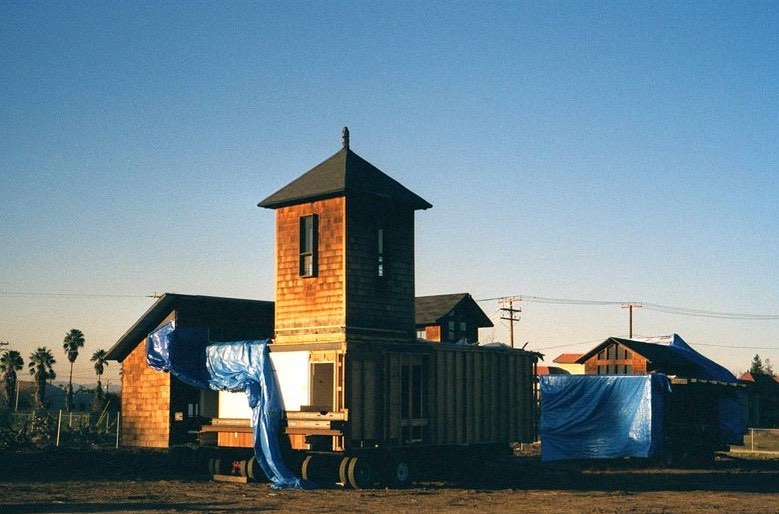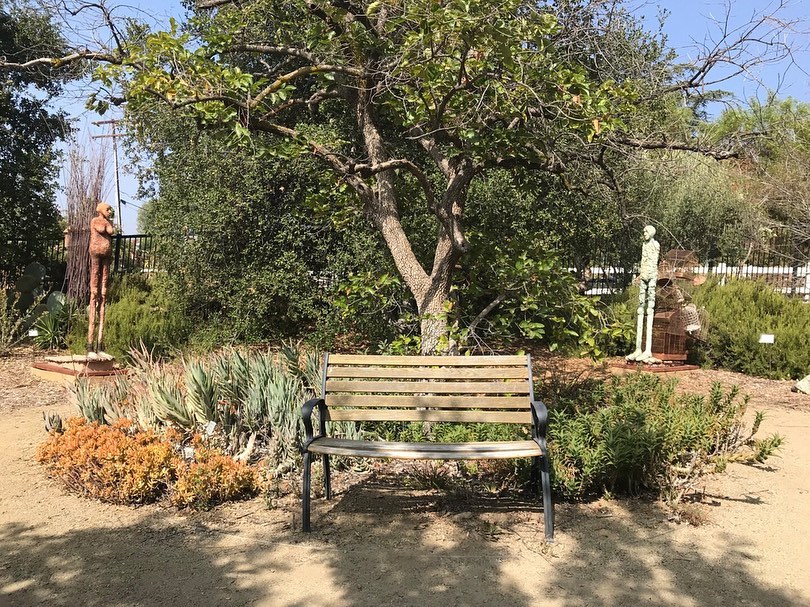All photos: The Sam and Alfreda Maloof Foundation for Arts and Crafts
On fertile Rancho Cucamonga ground replete with lemon trees and Mediterranean greenery stands the rustic Sam Maloof house. It may seem unassuming at first. Yet, an artist’s hands built virtually every square inch you see. In fact, it was constructed from the ground up by one of the world’s most recognized and acclaimed woodworkers of the modern era. Sam Maloof created furniture with soul; an admirable crusade that found him celebrated by artists, presidents, and celebrities alike. And he launched his modern art movement from a simple attached woodshop that you can visit in Rancho Cucamonga to this day.
Simple Beginnings for Sam Maloof
You might assume that a prominent leader of California’s renowned modern arts movement would have gone to prestigious art schools. Or, at the very least, apprenticed for established master artisans. But California-born Sam Maloof had just about as much acknowledgment as income growing up.
The son of Lebanese immigrants, he enjoyed a standard public education in 1920s Chino. When his inclinations eventually steered him toward woodworking, there was no mentor overseeing his work; no scholarships funding his climb to greatness. Rather, Maloof was self-taught and self-made.
The Genesis of the Sam Maloof House
When Maloof finally turned to his calling in woodworking, it was mostly out of necessity. He’d met a postgraduate student at Scripps College named Alfreda. She’d already enjoyed a storied career as an artist, teacher, and even served as the Director of Arts and Crafts for the Santa Fe Indian School.
In 1948, Sam Maloof married Alfreda. With a son on the way, the couple were happy, but not exactly wealthy. Yet, they needed a sanctuary to start their family. So, in 1952, Maloof rolled up his sleeves and, using the scant resources at his disposal, began to build a simple California ranch. It wasn’t easy, but the price was right.
Thus the Sam Maloof house became a solid reality. Nestled amongst groves of zesty lemon trees, the home provided a serene enclave in a cozy Rancho Cucamonga community. Spurred on by Alfreda’s encouragement, Maloof quickly exhibited a rare natural gift for finding another layer of tranquil beauty at the core of a raw piece of wood.
The Sam Maloof house itself was an accomplishment. But it was when Maloof began to create the furnishings for the home that the accomplishment became a career. He believed that there was a soul in wood; one he strove to bring to the surface in the over 5,000 pieces he created during his lifetime.
The Nexus of Furniture and Modern Art
The more that Maloof created, the more his acclaim spread. As commissions poured in, he needed to get serious about his work. Alfreda helped by managing the business side of his woodworking enterprise; a role she filled until her passing in 1998.
Even at the zenith of his popularity, spanning from the 1960s through the 1970s, Maloof never strayed from his handcrafted approach. It was integral for finding the soul of the piece. When you see an original piece of Maloof-crafted furniture today, you can rest assured that the hands of the artist or his team of assistants brought it into its lovely form .
Maloof’s Rise to Prominence in the Modern Art World
Like a sylvan King Midas, Maloof turned virtually every piece of wood he touched into something beautiful. Yet, his rocking chairs stirred particular acclaim. Such rustic rockers served as seats of repose for the likes of Jimmy Carter and Ronald Reagan among other less presidential luminaries.
In 1985, he became the first craftsperson to collect the prestigious MacArthur Fellowship, opening the door for woodworkers, ceramicists, and the like. By this point, he served as the unofficial axis for a collective of Pomona Valley artists. Over the years, they supported one another, either through words or traded art. Many of these pieces are still on display in the Sam Maloof house to this day.
In 2001, Maloof was honored with a career-spanning retrospective at the Smithsonian American Art Museum’s Renwick Gallery. His work has since become a part of the gallery’s permanent collection. The artist’s work also contributes to permanent collections at lauded museums such as the Boston Museum of Art and the New York Metropolitan Museum of Art. Maloof has even received honorary doctorates from a number of institutions including the Rhode Island School of Design.
Inside the Sam Maloof House of Rancho Cucamonga
We’ve told you a lot about the man but very little about the Sam Maloof house. Beyond the gently swaying limbs of the lemon trees proudly stood the hand-built residence along with its connected woodshop. Initially, it was a rather simple affair. But Maloof’s talent grew in stride with his creativity.
Under Alfreda’s encouragement, he replaced pre-fab fixtures with doors and window frames he carved himself from genuine redwood. Appropriately, Maloof whittled away the years, filling his home with his artfully crafted furniture and the rich fragrance of sawdust. Even the toilet seat was replaced with a Maloof original.
Relocating the Historic Maloof Residence
Yet, if you were to visit that same Rancho Cucamonga lemon grove today, you’d instead find the bustling Foothill Freeway extension. So, how are you still able to tour the Sam Maloof house today? Because the house was painstakingly moved to a new location.
Despite achieving eligibility for the National Register of Historic Places in 1990, the Maloof residence was standing in the way of progress. So, after an exhaustive search, Maloof himself chose a six-acre stretch of Rancho Cucamonga land with the San Gabriel Mountains serving as a backdrop.
While it was difficult for Maloof to uproot from a location with so much history, he oversaw the operation to make sure as much of the original property was brought along as possible. Along with the main structure, the adjoining woodshop made the journey. Even a few of the trees came along for the ride, though the new site boasted its own grove of cheerful lemon trees. When the dust had settled in the year 2000, the Sam Maloof house had been lovingly recreated in the location you’ll find it today.
The Sam Maloof Home Today
On November 9, 2010, just a year after Sam Maloof’s passing, his property was officially added to the National Register of Historic Places. Thanks to the efforts of the Sam and Alfreda Maloof Foundation for Arts and Crafts, you can tour the historic Sam Maloof house for yourself.
But when you visit, you’ll find so much more than a home. That’s because the home-turned-museum harbors a comprehensive collection of modern art collected by Maloof over the decades. You’ll find a diverse assortment of works in a multitude of media including painting, ceramic, and, of course, woodwork. But guests can also try their hand at making their own Maloof-style pieces in the original woodshop where all the magic happened.
While tours of the Sam Maloof house run at just under 30 dollars, workshops can run into the hundreds. Yet, if both are too steep for you, you can tour the lovely lemon-kissed, drought-tolerant gardens surrounding the home absolutely free. The property is peppered with majestic sculptures, benches offering repose, and plenty of scenic, meditative splendor.
It seems Maloof infused wood with his own spirit to create his timeless functional art. Yet, we’re sure he’d argue that he was simply exposing what was already there. While the approximately 5,000 pieces he bestowed on the world have found their way to museums and private collections, his style lives on, continuing to inspire. Yet, a visit to the Sam Maloof house may show that he lived in his own masterpiece.
Get the Story of Our Other Home Spotlights in Los Angeles, Palm Springs, Las Vegas and More
The Bob Hope House
The Chemosphere
The Spadena House
The Underground House
The Lonnie Hammargren House
The Most Expensive Mansion in the Coachella Valley
The Sowden House
The Invisible House & Mirage House
Casa de Shenandoah
The O’Neill House
The Elrod House
Hartland Mansion
Dawnridge
The Mosaic Tile House
The Lummis House
The Upton Sinclair House
With a brand that says as much as JohnHart’s, Senior Copywriter Seth Styles never finds himself at a loss for words. Responsible for maintaining the voice of the company, he spends each day drafting marketing materials, blogs, bios, and agent resources that speak from the company’s collective mind and Hart… errr, heart.
Having spent over a decade in creative roles across a variety of industries, Seth brings with him vast experience in SEO practices, digital marketing, and all manner of professional writing with particular strength in blogging, content creation, and brand building. Gratitude, passion, and sincerity remain core tenets of his unwavering work ethic. The landscape of the industry changes daily, paralleling JohnHart’s efforts to {re}define real estate, but Seth works to maintain the company’s consistent message while offering both agents and clients a new echelon of service.
When not preserving the JohnHart essence in stirring copy, Seth puts his efforts into writing and illustrating an ongoing series entitled The Death of Romance. In addition, he adores spending quality time with his girlfriend and Romeo (his long-haired chihuahua mix), watching ‘70s and ‘80s horror movies, and reading (with a particular penchant for Victorian horror novels and authors Yukio Mishima and Bret Easton Ellis). He also occasionally records music as the vocalist and songwriter for his glam rock band, Peppermint Pumpkin.


